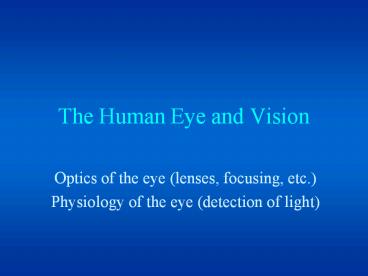The Human Eye and Vision - PowerPoint PPT Presentation
1 / 23
Title:
The Human Eye and Vision
Description:
The Human Eye and Vision Optics of the eye (lenses, focusing, etc.) Physiology of the eye (detection of light) Summary of Lecture The human eye can be modeled as a ... – PowerPoint PPT presentation
Number of Views:862
Avg rating:3.0/5.0
Title: The Human Eye and Vision
1
The Human Eye and Vision
- Optics of the eye (lenses, focusing, etc.)
- Physiology of the eye (detection of light)
2
Summary of Lecture
- The human eye can be modeled as a simple optical
system consisting of two lenses and a projection
screen for images. The cornea is the main
refractive element of the eye, with the
crystalline lens assisting to form an image on
the retina. Rods and cones in the retina are the
sensors that detect light. Common defects in the
visual system are myopia, hyperopia and
presbyopia. All can be corrected either with
eyeglasses or, more recently for the first two,
with surgical procedures.
3
Structure of the Eye
Diagram from National Eye Institute Website
4
Human Eye
Cornea most refraction Crystalline lens fine
tuning Ciliary muscles flex the lens Retina -
extension of the brain Fovea center of
retina Blind spot - Where the optic nerve leaves
the eyeball
5
Human Eye - Vision Receptors
Rods - more sensitive to low light levels
fewer in vicinity of fovea. Cones - bunched
together at fovea color sensitive used for
sharp images
6
Human Eye - Simple Model
7
Human Eye - Simple Model
What type of image is formed?
Real, inverted and demagnified.
Inverted ???
The brain takes care of interpreting the
information received at the retina. It
compensates for the contradictory sensory
information (e.g. inversion).
8
Human Eye - Cornea
Most refraction occurs at the cornea (ncornea
1.376) Index of refraction change is
greatest at that interface.
9
Human Eye - Goggles
Question Why is it that you can see better
underwater when wearing goggles?
Answer Without goggles, there is very little
refractive index change between the water and
your cornea. You effectively become
very far-sighted.
10
Human Eye - Crystalline Lens
- Crystalline lens fine tunes the focus
- (we call this accomodation)
- Cornea-to-retina distance is fixed
- What change is needed in the lens
- to allow focusing of an object
- as it moves closer?
- The lens must take on a shorter focal
- length (i.e. become more converging)
11
Eye Optics of Marine Mammals
1. What first led Heather Zorn to think
about marine mammal eyes? 2. What is the major
difference between the conditions under which
our eyes (or those of a fish) operate, and
those of marine mammals? 3. When you open your
eyes under water without using goggles, do you
become near-sighted or far-sighted? Why is there
a change at all? 4. How might the cornea play
a role in marine mammal vision? The pupil? The
crystalline lens? Which is most important?
12
Human Eye - Abnormalities
Myopia - Near-sightedness Hyperopia -
Far-sightedness Presbyopia - Age-related decrease
in accomodation ability In all cases, the lens
cannot compensate for all object distances.
13
Normal Eye
Object at infinity
Retina ("screen")
14
Myopia Near-sightedness
Retina("screen")
15
Correcting Myopia
How to determine your prescription If you are
near-sighted 1. Find your far-point
distance 2. Convert this to meters 3. Take the
inverse of this number 4. The result is your
prescription, if you put a - in front.
16
Correcting Myopia
Another possibility for correcting
myopia? Radial keratotomy (RK) Photorefractive
keratectomy (PRK) LASIK (Laser-assisted in
situ keratomileusis)
17
Hyperopia Far-sightedness
Normal near point is 25cm (10")
18
Hyperopia Far-sightedness
Near point
Object gives fuzzy image because it is too
close.
Retina ("screen")
New image is at the near point
19
Correcting Hyperopia
Are there surgical options for correcting hyperop
ia?
Yes, LASIK can help out here as well.
20
Presbyopia
Age-related lack of ability to focus on nearby
objects Crystalline lens becomes less
flexible Not surgically correctable by
changing the cornea. Why?
21
Astigmatism
Cornea is not spherical Vertical and
horizontal objects focus at different distances
from the cornea.
22
Eyeglasses?
When do eyeglasses first appear? Roger Bacon?
(13th century) Umberto Ecos The Name of the
Rose Principles were not understood, however.
23
Kepler (ca. 1600) Solves the Problem
He was the first to theoretically understand how
images are formed by lenses. Kepler still did not
have an exact mathematical formula to describe
the phenomenon, however.
Museum der Sternwarte Kremsmünster, Austria































